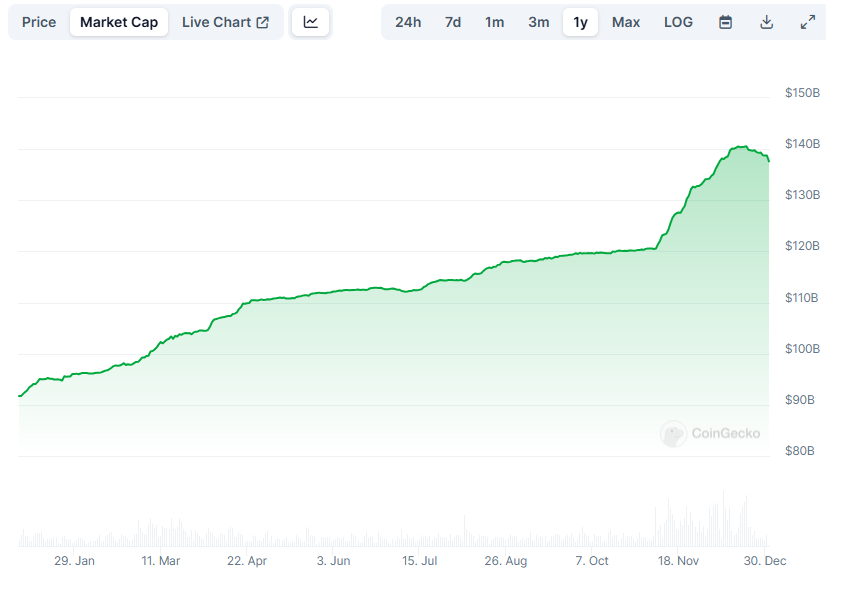Tether burned 1B of USDT supply on the last day of 2024, at the end of a year when record USDT liquidity was injected into the market. The token burn raised questions about the direction of the crypto market.
Tether, Inc. burned 1B Tether (USDT), with no explanations on technicalities. The burn decreased the USDT supply from 138B to 137B, arriving after a series of smaller liquidity withdrawals.

The removal of $1B liquidity followed 10 days of gradually decreasing the supply, causing one of the first supply contractions since 2022. The recent removal of USDT was the biggest single burn for the past week, increasing the rate of reversal of USDT growth for the past year. The leading stablecoin expanded its supply constantly for the past 12 months.
The supply of USDT peaked above 140B tokens, becoming one of the supporting factors for the peak Bitcoin (BTC) rally. The recent burn coincided with a market-wide dip, which briefly sent BTC under $93,000.
After the recent token burns, the overall supply of stablecoins decreased from its peak of 200.2B, down to 198.5B. The contraction mostly affected USDT, while synthetic or crypto-backed stablecoins grew independently or retained their supply.
Tether removes USDT from TRON
The recent removal of USDT liquidity affected the tokens on the TRON network. The supply on Ethereum remains at more than 76.9B tokens, while TRON-based TRC-20 stablecoins were burned.
Tether Treasury sent out a single transaction to destroy 2B USDT on the TRON network. The burn is part of the policy to move more USDT to its Ethereum version, the most widely used one for both centralized trading and DeFi.
On TRON, the supply of USDT is down to 59.75B tokens, spread to more than 58K holders. On-chain analysts noticed some centralized exchanges tried to move out of TRON-based USDT, both through swaps and redemptions, which may be the cause of the token burn.
TRON-based USDT is also used for retail and peer-to-peer activities and often carries the most valuable transactions of over $100K. However, whales and exchanges remain more influential than retail.
Bitfinex and Binance have attempted redemptions of TRON-based USDT. In the case of Bitfinex, more than 743M USDT were redeemed. The redemptions, swaps or other ways of moving away from TRC-20 stablecoins are still not leading to more mints on Ethereum.
TRC-20 USDT is predominantly held by whales in comparison to Ethereum’s stablecoin. More than 85% of all TRON-based stablecoins are in whale wallets or held by exchanges, hence the more coordinated shift to a new type of stablecoin.
The rapid divestment of TRC-20 stablecoins led to a short-term loss of the $1 stability, as USDT dipped to $0.9987. The difference is small, but it showed shifting pressures on USDT reserves. Previously, Tether has redeemed and burned tokens from other networks, including TRON, with no major effects on the market.
The current shift in holdings may boost Ethereum-based DeFi. The USDT stablecoin is one of the most active smart contracts, producing the biggest daily fees among all chains.
Will the Euro area still use USDT?
One of the hypotheses for the decreasing USDT supply is the expectation for lowered usage in the European Union after the removal of non-compliant stablecoins. There are already signs that the European market is shifting to compliant stablecoins like USDC.
The European market ranks high in terms of crypto activity, although it still lags behind the USA. The upcoming regulation of USDT may further slow down usage and innovation, with the rationale of higher security.
Tether, Inc. is yet to acquire a license for EU-based banking, to provide the requisite reserves for making USDT compliant. EU-based services still swapped the token, but exchanges like Binance may remove some of its products and trading pairs, especially if using leveraged positions.
USDT remained one of the most widely used assets, and Tether may yet produce a compliant version of the token. The 2024 bull market led Tether to achieve $2.55B in annual fees, based on the token’s daily usage.
A Step-By-Step System To Launching Your Web3 Career and Landing High-Paying Crypto Jobs in 90 Days.










